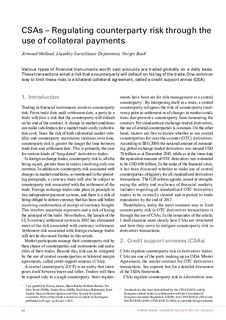CSAs – Regulating Counterparty Risk Through the Use of Collateral Payments
| dc.contributor.author | Molland, Jermund | |
| dc.date.accessioned | 2018-06-28T13:10:32Z | |
| dc.date.available | 2018-06-28T13:10:32Z | |
| dc.date.issued | 2011 | |
| dc.identifier.issn | 1503-8831 | |
| dc.identifier.uri | http://hdl.handle.net/11250/2503655 | |
| dc.description.abstract | Counterparty risk associated with trading in financial instruments can be substantial. This applies especially to certain types of derivatives trades with long-dated contracts. The most common way to mitigate this risk for OTC derivatives transactions is to use bilateral CSAs. CSAs enable parties to a trade to reduce risk by posting collateral to counterparties. This article describes in detail how such agreements are structured. | nb_NO |
| dc.language.iso | eng | nb_NO |
| dc.publisher | Norges Bank | nb_NO |
| dc.rights | Attribution-NonCommercial-NoDerivatives 4.0 Internasjonal | * |
| dc.rights.uri | http://creativecommons.org/licenses/by-nc-nd/4.0/deed.no | * |
| dc.title | CSAs – Regulating Counterparty Risk Through the Use of Collateral Payments | nb_NO |
| dc.type | Journal article | nb_NO |
| dc.subject.nsi | VDP::Samfunnsvitenskap: 200::Økonomi: 210::Samfunnsøkonomi: 212 | nb_NO |
| dc.source.pagenumber | 64-67 | nb_NO |
| dc.source.journal | Economic Bulletin | nb_NO |
| dc.source.issue | 2011 | nb_NO |
Files in this item
This item appears in the following Collection(s)
-
Penger og Kreditt / Economic Bulletin [473]
1973 (1999)-2012

